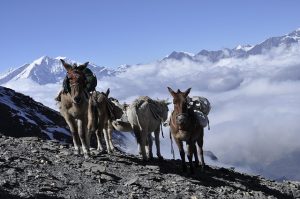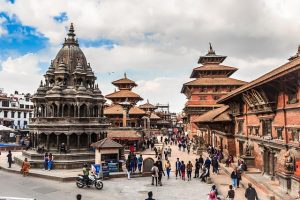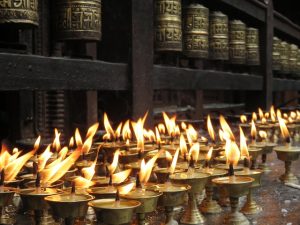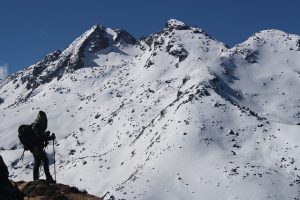【後編】エベレストとダルバートの国・ネパール 〜夢見る青年が語る未来〜
【後編】エベレストとダルバートの国・ネパール 〜夢見る青年が語る未来〜
 イメージ
イメージ
前回に引き続き、ネパール出身の青年との交流から見えてきた、
ネパールの暮らしや文化、そして壮大な自然と彼の将来の夢についてお届けします。
ネパールの生活費と物価感覚
ネパールでの1か月の生活費は以下の通りだそうです:
家賃:約6,000円 食費:約6,000円 雑費:約3,000円
合計でおよそ15,000円程度。ネパールの1人あたりの年収は
約2,000ドル(30万円)ほどなので、物価はかなり低く感じられます。
スマホは生活必需品
スマートフォンは現地でも広く普及しており、SNS、通話、翻訳など、
彼にとってもなくてはならないコミュニケーションツールとなっています。
驚きの車価格とインフラ事情
日本で300万円の車が、ネパールでは関税がなんと300%!
結果、約1,000万円にもなるとのこと。
中古車販売店も少なく、車を持つこと自体が「一部の富裕層の夢」だそうです。
 イメージ
イメージ
ヒマラヤ山脈とエベレストの神秘
ネパールといえば、やはりヒマラヤ山脈。世界の高山トップ10のうち、
8峰がネパールにあります。
中でも有名なのが、世界最高峰「エベレスト(標高8,848m)」です。
登山には往復1か月ほどかかり、高山病対策のため少しずつ標高を
上げていく必要があります。
途中からは交通手段もなく、歩くしかないそうです。
登山者を支える「シェルパ」は、なんと約50kgの荷物を背負って山を登ります。
彼も「自分にはとても無理です」と笑っていました。
私ももちろん無理です(笑)。
ちなみに私は「エベレストビール」を飲んだことがあると言うと、
彼も思わず笑ってくれました。
ネパールの郷土料理を紹介!
ネパールの家庭料理といえば「ダルバート」。
ご飯(バート)に豆のスープ(ダル)、野菜の炒め物や漬物を添えた
定食スタイルです。
スパイスは香り高く、辛さは比較的控えめ。
手で食べるスタイルが一般的ですが、スプーンでもOKだそうです。
他にも、「モモ」という小籠包に似た蒸し餃子や、
「セルロティ」という甘いドーナツ状のお菓子も人気。
どれも素朴ながら滋味深く、日本人の口にも合う味でした。
 イメージ
イメージ
社会と隣国との関係
ネパールでは銃器や刃物の所持が禁じられており、治安は比較的良好です。
隣国・インドとは「兄弟のような関係」で、ビザやパスポートなしで
自由に行き来できるとのこと。
私は「インドでスズキ車が人気だから、ネパールでも可能性あるかも」
と話したところ、彼も興味津々の様子でした。
将来はネパールで国際ビジネスを
彼の夢は、将来ネパールに戻り、国際的なビジネスを起こすこと。
語学力・勤勉さ・まじめな人柄から見ても、
きっと成功するだろうと感じました。
ただし、ネパールにはまだ基幹インフラの整備や産業の育成
といった課題も残っています。
隣国・中国との外交的なバランスも重要になるでしょう。
それでも、こうした志を持つ若者たちが母国を少しずつ変えていく。
その姿を応援したい、そんな気持ちにさせてくれる出会いでした。
続く!
 image
image
“Part II: The Land of the Himalayas and Dal Bhat—
A Young Dreamer’s Vision for the Future
Continuing from my previous post, here’s what I learned about life and
culture in Nepal—from conversations with a young man born there—
along with the country’s breathtaking natural landscapes and
his dreams for the future.
Cost of Living and Sense of Prices in Nepal
According to him, a typical month’s expenses in Nepal break down roughly as follows:
- Rent: ¥6,000
- Food: ¥6,000
- Miscellaneous: ¥3,000
That brings the total to about ¥15,000 per month.
With the per-capita annual income around USD 2,000 (roughly ¥300,000),
prices really do feel low.
Smartphones as a Necessity
Smartphones are already widespread in Nepal.
For him, they’re indispensable tools—for social media, calls,
translation, and staying connected.
Astounding Car Prices and Infrastructure
A car that costs ¥3 million in Japan incurs an astonishing 300% import duty in Nepal—
driving its price up to about ¥10 million.
With few used-car dealers, owning a car remains “a dream for only the wealthiest.”
 image
image
The Majesty of the Himalayas and Everest
Nepal is home to eight of the world’s top ten highest peaks.
The most famous is Mount Everest (8,848 m).
A round-trip climb takes about one month,
with gradual altitude gain to guard against acute mountain sickness.
Beyond a certain point there are no roads—only footpaths.
The Sherpas who support climbers carry up to 50 kg of supplies on their backs.
He laughed and said, “That’s just impossible for me.”
And I have to admit—I’d never manage it either!
(By the way, when I told him I’d tried “Everest Beer,”
he couldn’t help but laugh.)
Introducing Nepalese Home Cooking
In Nepalese homes, you’ll often find Dal Bhat—a set meal of steamed rice (bhat),
lentil soup (dal), and assorted vegetable sides or pickles.
The spices are aromatic but not overly hot.
While eating by hand is traditional, spoons are perfectly acceptable.
Other favorites include Momo (steamed dumplings similar to soup dumplings) and
Sel Roti (a sweet, doughnut-shaped bread).
Simple yet deeply flavorful, they suit the Japanese palate surprisingly well.
Society and Relations with Neighboring Countries
Nepal prohibits private ownership of firearms and knives,
contributing to generally good public safety.
With neighboring India, Nepal enjoys a “brotherly” relationship—
no visas or passports are needed to travel back and forth freely.
When I mentioned, “Suzuki cars are popular in India;
maybe there’s potential for them in Nepal, too,”
he perked up with interest.
 image
image
A Future in International Business
His dream is to return to Nepal and launch an international business.
Given his language skills, work ethic, and earnest character,
I have no doubt he’ll succeed.
Yet challenges remain: developing core infrastructure,
nurturing domestic industries,
and managing diplomatic balance with neighboring China.
Still, it’s inspiring to see young people like him committed to
gradually transforming their homeland.
I left our conversation feeling eager to support their vision.
To be continued…

